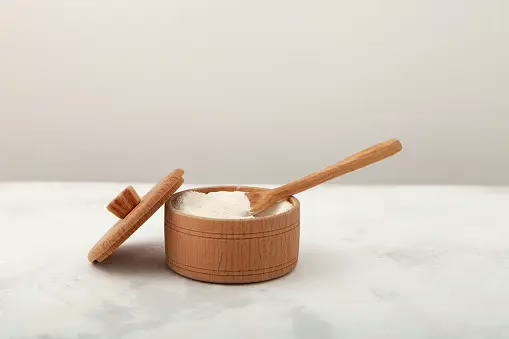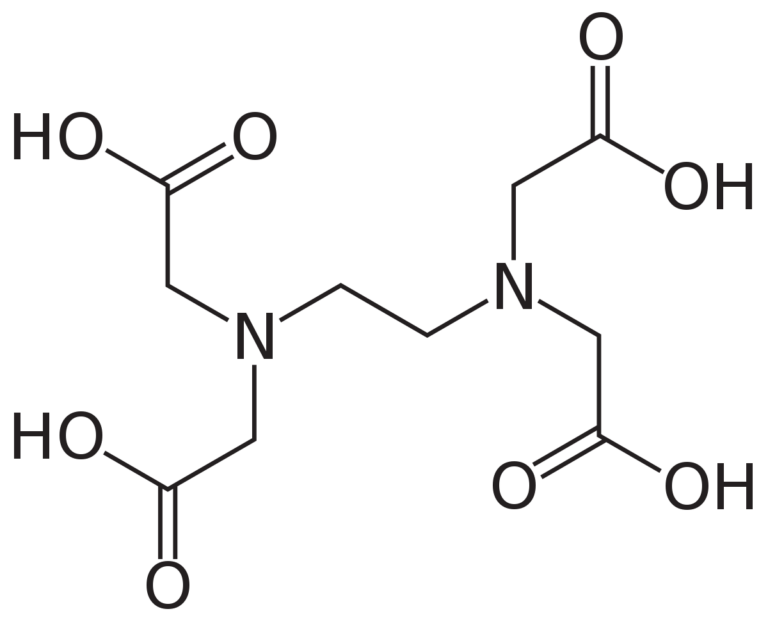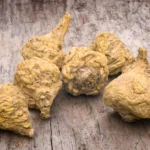Introduction:
Looking to add some oomph to your culinary creations? Look no further than xanthan gum. Derived from fermented sugar, this common ingredient is a versatile thickening and stabilizing agent that can elevate your salad dressings and rice dishes to the next level. It is used in many foods.
Unlike other food additives, the powder provides both viscosity and texture, making it a go-to ingredient in various industries. It has become increasingly popular due to its ability to enhance the growth and quality of rice in the food supply. Whether you’re whipping up salad dressings, sauces, or bakery items, this gluten-free and vegan-friendly powder, which does not contain any food additives, is a common ingredient in many foods and has got you covered in terms of the food supply.
But its benefits don’t stop there. Xanthan gum also plays a role in digestion. While it may sound counterintuitive, this soluble fiber actually helps regulate the flow of liquids through the digestive tract, promoting smoother swallowing and absorption of nutrients in many foods. This is important for maintaining a healthy food supply and providing essential information about plants.
So if you’re looking for an easy way to enhance the texture of many foods and plants in your favorite recipes while supporting healthy digestion, give it a try. It is a great option for synthesis and provides useful information. Your taste buds and tummy will thank you.
Estimated reading time: 16 minutes
Uses and Benefits of Xanthan Gum
Xanthan gum is a versatile ingredient that offers numerous benefits in various applications. It can be found in many foods and provides valuable information to people. Its sheer properties make it an essential component in many food products. It can be found in many foods and provides valuable information to people. Its sheer properties make it an essential component in many food products. Let’s explore some of the advantages that foods bring to people and the table.
Enhances Shelf Life by Preventing Ingredient Separation
One of the key benefits of xanthan gum is its ability to enhance the shelf life of foods by preventing ingredient separation. This is important because people want their food products to last longer. When added to dressings, sauces, and other liquid-based foods, it acts as an emulsifier, ensuring that oil and water do not separate over time for people. This helps maintain the desired consistency and texture of foods, providing a better overall sensory experience for people.
Improves Texture and Mouthfeel in Ice Creams and Frozen Desserts
Xanthan gum plays a crucial role in improving the texture and mouthfeel of foods for people. It acts as a stabilizer for foods, preventing ice crystals from forming during freezing. This is beneficial for people who want to maintain the quality of their frozen goods. This results in smoother, creamier ice creams that are more enjoyable to eat, especially when made with high-quality foods. It helps prevent foods from melting too quickly or becoming icy when exposed to temperature fluctuations.
Helps Create Gluten-Like Consistency in Gluten-Free Baked Goods
For individuals with gluten intolerance or celiac disease, finding suitable alternatives for traditional baked goods can be challenging. This powder comes to the rescue by providing gluten-like consistency in gluten-free recipes. It acts as a binder, mimicking the structure that gluten provides in regular baking. This allows for better dough elasticity and improved rise during baking.
Acts as a Binder in Meat Products, Improving Water Retention
In meat processing, xanthan gum serves as an excellent binder due to its unique properties. It enhances water retention in meat products such as sausages or burgers, helping them retain moisture during cooking. This results in juicier and more succulent meat dishes that are less prone to drying out.
Used in Personal Care Products like Toothpaste for Its Thickening Properties
Xanthan gum is not limited to the realm of food; it also finds its way into personal care products. Due to its thickening properties, it is commonly used in toothpaste formulations. It helps create a smooth and consistent texture while ensuring that the toothpaste adheres well to the toothbrush during use.
Health benefits :
Promotes Digestive Health by Adding Bulk to Stool
For individuals struggling with digestive issues such as constipation, this powder can be beneficial. It acts as a dietary fiber, adding bulk to stool and promoting regular bowel movements. This can help alleviate symptoms of constipation and improve overall digestive health.
Helps Manage Blood Sugar Levels in Diabetic Individuals
Studies have shown that xanthan gum may help regulate blood sugar levels, making it potentially beneficial for individuals with diabetes. When consumed with meals, it slows down the absorption of carbohydrates, leading to more stable blood glucose levels after eating.
Supports Weight Loss Efforts by Increasing Satiation
Due to its ability to add bulk and viscosity to foods, it can contribute to increased satiety or feelings of fullness. This can be particularly helpful for those trying to manage their weight or reduce calorie intake.
Side Effects and Safety Considerations of Xanthan Gum
Generally Safe, but Watch Out for Digestive Issues
Xanthan gum is generally considered safe when consumed within recommended amounts. It is commonly used as a food additive and thickening agent in a wide range of products. However, it’s important to note that some individuals may experience digestive issues after consuming the powder.
One of the most common side effects associated with this ingredient is digestive discomfort, such as bloating or gas. This can occur because it has a laxative effect and can increase the volume of stool in the intestines. As a result, it may cause temporary digestive disturbances in sensitive individuals.
Allergic Reactions: Rare but Possible
While allergic reactions to xanthan gum are rare, they are still possible, especially among those who have known allergies to corn or soy. Xanthan gum is produced through fermentation using bacteria that feed on sugars derived from these sources. Therefore, individuals with allergies to corn or soy should exercise caution when consuming products containing this ingredient.
If you suspect you have an allergy or experience symptoms such as hives, itching, swelling, or difficulty breathing after consuming it, seek medical attention immediately. An allergist can perform tests to determine if you have an allergy and provide guidance on avoiding further exposure.
Consult Your Doctor if You Have Underlying Health Conditions
People with underlying health conditions should consult their doctor before consuming supplements or products containing high concentrations of this ingredient. While there is no strong evidence suggesting it has poses significant risks for most people, those with certain conditions may need to exercise caution.
For example, individuals with gastrointestinal disorders like inflammatory bowel disease (IBD) or irritable bowel syndrome (IBS) may be more susceptible to experiencing adverse effects from xanthan gum consumption. Those with a history of intestinal blockage or difficulty swallowing should consult their healthcare provider before using this product.
Pay Attention to Labels and Dosage
When using products that contain xanthan gum, it’s important to read labels carefully and follow recommended dosage instructions. The powder is often found in a variety of food products, such as salad dressings, sauces, and gluten-free baked goods. While it is generally safe in these small quantities, excessive consumption may lead to digestive discomfort.
If you are unsure about the safety of consuming the product or have any concerns, it’s always best to consult with a healthcare professional. They can provide personalized advice based on your specific health needs and help determine whether xanthan gum is appropriate for you.
How to Use Xanthan Gum in Cooking and Baking
Xanthan gum is a versatile ingredient that can be used as a thickener in both cooking and baking. It has the ability to create a smooth, creamy texture and improve the stability of various dishes. However, using it correctly is crucial to achieving the desired results. Here are some tips on how to use xanthan gum effectively in your culinary creations.
Start with small quantities
When using xanthan gum as a thickener, it’s best to start with small quantities. Begin with around ¼ teaspoon of xanthan gum for recipes that yield approximately four cups of liquid. This will ensure that you don’t overpower the dish with its thickening properties.
Dissolve it thoroughly
To prevent clumping, it’s important to dissolve it thoroughly before adding heat. This can be done by mixing it with cold liquids first. Gradually sprinkle the xanthan gum into the liquid while whisking vigorously or using an immersion blender until it is completely dissolved.
Allow time for hydration
After dissolving the xanthan gum, allow it some time for hydration. Typically, this process takes around 15 minutes. During this time, the mixture will thicken further as the xanthan gum absorbs moisture and expands. It’s essential to factor in this hydration period when evaluating the thickness of your mixture.
Adjust based on consistency
The amount of this gluten free powder needed may vary depending on the desired consistency of your dish. If you find that your mixture is too thin or runny after hydrating, you can add more xanthan gum in small increments (around ⅛ teaspoon) until you achieve your desired thickness.
On the other hand, if you add too much of it, you may end up with a slimy or gelled texture in your final product. Therefore, it’s important to exercise caution and add xanthan gum gradually, adjusting as needed.
Baking with xanthan gum
Xanthan gum is particularly useful in gluten-free baking. It helps provide structure and elasticity to baked goods that lack the binding properties of gluten. Here are some key points to keep in mind when using the powder in baking:
- For recipes that call for wheat flour, a general guideline is to add ¼ teaspoon of xanthan gum per cup of flour.
- Mix the xanthan gum with the dry ingredients before incorporating them into the wet ingredients.
- Be mindful not to overmix the batter once you’ve added the xanthan gum, as this can lead to a dense or gummy texture in your baked goods.
Remember that experimentation may be necessary when using this ingredient in baking. Different recipes and flours may require slight adjustments to achieve optimal results.
Substitutes for Xanthan Gum in Recipes
If you’ve run out of xanthan gum or simply want to explore alternative options, there are several substitutes that can be used as thickening agents or binding agents in your recipes. These alternatives offer similar properties and can be easily incorporated into various dishes. Let’s take a closer look at some of the popular substitutes:
Guar Gum: A Common Ingredient with Similar Properties
Guar gum is a natural food ingredient derived from guar beans. It shares many similarities with xanthan gum, making it an excellent substitute in recipes that require thickening or binding effects. Like xanthan gum, guar gum also contains long chains of repeat units that create a gel-like substance when mixed with liquids. It is commonly used in salad dressings, sauces, and baked goods such as muffins.
Pros:
- Similar thickening and binding properties to xanthan gum
- Widely available in most grocery stores
- Works well in gluten-free recipes
Cons:
- Can cause digestive issues if consumed in large quantities
- May alter the texture slightly compared to xanthan gum
Psyllium Husk Powder: A Natural Binding Agent
Psyllium husk powder is another viable option when looking for a substitute. It is derived from the seeds of the Plantago ovata plant and provides excellent binding effects similar to xanthan gum. When combined with liquid, psyllium husk powder forms a gel-like substance that helps hold ingredients together.
Pros:
- Natural and gluten-free substitute for xanthan gum
- Provides additional fiber to recipes
- Suitable for baking bread and other gluten-free goods
Cons:
- Can change the texture and taste slightly compared to xanthan gum
- Requires careful measurement due to its high absorption capacity
Chia Seeds: A Nutritious Alternative
Chia seeds are not only a healthy addition to your diet but can also be ground into a powder and used as a natural substitute for xanthan gum. These tiny seeds contain soluble fiber that forms a gel-like substance when mixed with liquid, providing binding properties similar to this powder.
Pros:
- Nutrient-rich alternative to xanthan gum
- Adds additional texture and crunch to recipes
- Suitable for vegan and gluten-free diets
Cons:
- May alter the taste and appearance of certain dishes
- Requires grinding into a powder before use
Arrowroot Powder: A Versatile Thickening Agent
Arrowroot powder is derived from the roots of the arrowroot plant and can be used as a substitute for xanthan gum in various recipes. It acts as a thickening agent, making it ideal for sauces, gravies, and other dishes that require viscosity.
Pros:
- Natural and gluten-free option
- Provides a smooth texture without altering the taste
- Works well in both hot and cold preparations
Cons:
- Can break down if exposed to prolonged heat or acid
- This may result in slightly less elasticity compared to xanthan gum
Gelatin or Agar-Agar: Alternatives for Specific Recipes
In some recipes, such as desserts or gummy candies, gelatin or agar-agar can be used instead of xanthan gum. Gelatin is derived from animal collagen, while agar-agar is obtained from seaweed. Both substances have gelling properties that can help achieve similar effects to xanthan gum.
Pros:
- Ideal for setting desserts, jellies, or gummy candies
- Provides excellent texture and stability
- Widely available in most grocery stores
Cons:
- Not suitable for vegetarian or vegan diets (gelatin)
- Requires specific preparation methods (agar-agar)
While these substitutes offer viable alternatives to xanthan gum in various recipes, it’s important to note that they may have slight differences in texture, taste, or functionality. It’s recommended to experiment with different substitutes and adjust quantities as needed to achieve the desired results in your dishes.
Xanthan Gum in Gluten-Free Foods and Allergies
Xanthan gum is a widely used ingredient in gluten-free baking, particularly in the production of bread and other baked goods. Its purpose is to improve the texture and elasticity of these products, which can often be challenging to achieve without the presence of gluten.
Widely used in gluten-free baking to improve texture and elasticity.
Gluten, a protein found in wheat and many other grains, provides structure to baked goods. It gives them their characteristic chewiness and helps them hold together. However, for individuals with celiac disease or gluten sensitivity, consuming gluten can lead to digestive issues and other health problems. This is where xanthan gum comes into play.
When gluten is removed from recipes, it becomes difficult to replicate its structural properties. This is where xanthan gum steps in as an excellent substitute. It acts as a binder, holding ingredients together and providing the necessary structure for bread and other baked goods. As a result, gluten-free products made, have better texture and are less likely to crumble apart.
Provides structure to gluten-free bread, preventing it from becoming crumbly.
One of the biggest challenges faced by those who follow a gluten-free diet is finding bread that doesn’t fall apart or turn out overly dense. Xanthan gum addresses this issue by mimicking the effects of gluten on dough. It helps trap air bubbles during the fermentation process, resulting in lighter and fluffier bread.
Without xanthan gum, gluten-free bread would lack the necessary binding agent that holds everything together. The absence of this ingredient often leads to dryness, crumbliness, and an overall unsatisfactory eating experience. With this powder added to the recipe, however, these issues are mitigated as it provides the necessary structure for a more enjoyable loaf of bread.
Individuals with corn or soy allergies should check the source of xanthan gum, as it is often derived from these ingredients.
While xanthan gum itself does not contain gluten, individuals with other food allergies need to be cautious. It is typically produced through a fermentation process using bacteria that feed on sugars derived from various sources. The most common sources are corn and soy. For those who have allergies or sensitivities to corn or soy, it’s essential to check the source of the xanthan gum used in food products. Some manufacturers may use alternative sources such as wheat or dairy derivatives, but these are less common. It’s always best to read ingredient labels carefully and consult with healthcare professionals if you have any concerns about potential allergens.
Medication Interactions and Allergy Considerations
Medication Interactions
When consuming xanthan gum, it’s important to be aware that it may interact with certain medications, potentially affecting their absorption. This is particularly true for medications that are taken orally and rely on proper absorption into the bloodstream to be effective. It has a thickening effect and can increase the viscosity of liquids, which may interfere with the dissolution and absorption of medication in the digestive system.
To ensure the effectiveness of your medication, it is advisable to consult with your healthcare provider or pharmacist before consuming products containing this powder. They will be able to provide guidance on whether any potential interactions exist between your specific medications and xanthan gum.
Allergy Considerations
Individuals who have known allergies to corn or soy should exercise caution when consuming products that contain xanthan gum. It is typically derived from these sources, as well as other carbohydrates such as wheat or dairy. While the manufacturing process removes most allergenic proteins, there is still a possibility of cross-contamination or trace amounts remaining in the final product.
If you have a known allergy to corn or soy, it is important to read product labels carefully and look for alternative options if necessary. Discussing your allergies with food service providers or manufacturers can help ensure that they are aware of your dietary restrictions and can provide suitable alternatives.
It’s worth noting that allergic reactions specifically related to xanthan gum itself are extremely rare. However, individuals who experience symptoms such as hives, itching, swelling, difficulty breathing, or gastrointestinal distress after consuming products containing xanthan gum should seek immediate medical attention.
Large Doses and Blood Sugar Spikes
Another consideration when using xanthan gum is its potential impact on blood sugar levels when consumed in large doses. It has been found to have minimal effects on blood sugar levels in small quantities, making it a suitable option for individuals following a low-carbohydrate or diabetic diet. However, when consumed in large amounts may contribute to blood sugar spikes.
If you are using xanthan gum as a thickening agent or binder in recipes, it is important to use it in moderation and be mindful of portion sizes. Incorporating other low-glycemic index ingredients alongside xanthan gum can help mitigate any potential impact on blood sugar levels.
Is Xanthan Gum a Healthy Food Additive?
Now that we’ve explored the uses, benefits, side effects, and various considerations of xanthan gum, you might be wondering whether it’s a healthy food additive. The answer is yes! Xanthan gum is generally considered safe for consumption and has been approved by regulatory authorities around the world. It can be an excellent addition to your cooking and baking endeavors, especially if you’re following a gluten-free diet or looking to improve the texture and stability of your recipes.
However, as with any food additive, moderation is key. While xanthan gum offers numerous benefits and versatility in the kitchen, it’s always important to read labels and ensure you’re not consuming excessive amounts. As with any dietary change or ingredient introduction, it’s also wise to consult with a healthcare professional if you have specific concerns or medical conditions.
So go ahead and embrace the power of this powder in your culinary adventures. Experiment with its thickening properties in sauces, dressings, and baked goods. Enjoy the convenience it brings to gluten-free recipes. Just remember to use it wisely and savor the delicious results!
FAQs
Can I use xanthan gum as a substitute for gluten in my recipes?
Yes! It can help mimic some of the properties of gluten in recipes like breads and pastries. However, keep in mind that it won’t provide exactly the same texture or structure as gluten does.
Are there any natural alternatives to using xanthan gum?
Absolutely! If you prefer natural alternatives, ingredients like psyllium husk powder or flaxseed meal can be used as substitutes for xanthan gum in certain recipes.
Can I use too much xanthan gum in my cooking?
Using excessive amounts of it can result in overly gummy or slimy textures in your dishes. It’s best to follow the recommended measurements and use moderation.
Is xanthan gum safe for people with allergies?
Xanthan gum is generally safe for individuals with common food allergies. However, if you have specific concerns or known allergies, it’s always advisable to check labels and consult with a healthcare professional.
Where can I purchase xanthan gum?
It is widely available in grocery stores, health food stores, and online retailers. Look for it in the baking or gluten-free sections of your local supermarket, or explore online options for convenience.








